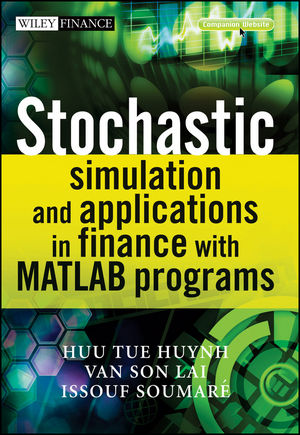Stochastic Simulation and Applications in Finance with MATLAB ProgramsISBN: 978-0-470-72538-2
Hardcover
360 pages
December 2008
 This is a Print-on-Demand title. It will be printed specifically to fill your order. Please allow an additional 10-15 days delivery time. The book is not returnable.
|
||||||
Preface
1 Introduction to Probability
1.1 Intuitive Explanation
1.2 Axiomatic Definition
2 Introduction to Random Variables
2.1 Random Variables
2.2 Random Vectors
2.3 Transformation of Random Variables
2.4 Transformation of Random Vectors
2.5 Approximation of the Standard Normal Cumulative Distribution Function
3 Random Sequences
3.1 Sum of Independent Random Variables
3.2 Law of Large Numbers
3.3 Central Limit Theorem
3.4 Convergence of Sequences of Random Variables
4 Introduction to Computer Simulation of Random Variables
4.1 Uniform Random Variable Generator
4.2 Generating Discrete Random Variables
4.3 Simulation of Continuous Random Variables
4.4 Simulation of Random Vectors
4.5 Acceptance-Rejection Method
4.6 Markov Chain Monte Carlo Method (MCMC)
5 Foundations of Monte Carlo Simulations
5.1 Basic Idea
5.2 Introduction to the Concept of Precision
5.3 Quality of Monte Carlo Simulations Results
5.4 Improvement of the Quality of Monte Carlo Simulations or Variance Reduction Techniques
5.5 Application Cases of Random Variables Simulations
6 Fundamentals of Quasi Monte Carlo (QMC) Simulations
6.1 Van Der Corput Sequence (Basic Sequence)
6.2 Halton Sequence
6.3 Faure Sequence
6.4 Sobol Sequence
6.5 Latin Hypercube Sampling
6.6 Comparison of the Different Sequences
7 Introduction to Random Processes
7.1 Characterization
7.2 Notion of Continuity, Differentiability and Integrability
7.3 Examples of Random Processes
8 Solution of Stochastic Differential Equations
8.1 Introduction to Stochastic Calculus
8.2 Introduction to Stochastic Differential Equations
8.3 Introduction to Stochastic Processes with Jump
8.4 Numerical Solutions of some Stochastic Differential Equations (SDE)
8.5 Application case: Generation of a Stochastic Differential Equation using the Euler and Milstein Schemes
8.6 Application Case: Simulation of a Stochastic Differential Equation with Control and Antithetic Variables
8.7 Application Case: Generation of a Stochastic Differential Equation with Jumps
9 General Approach to the Valuation of Contingent Claims
9.1 The Cox, Ross and Rubinstein (1979) Binomial Model of Option Pricing
9.2 Black and Scholes (1973) and Merton (1973) Option Pricing Model
9.3 Derivation of the Black-Scholes Formula using the Risk-Neutral Valuation Principle
10 Pricing Options using Monte Carlo Simulations
10.1 Plain Vanilla Options: European put and Call
10.2 American options
10.3 Asian options
10.4 Barrier options
10.5 Estimation Methods for the Sensitivity Coefficients or Greeks
11 Term Structure of Interest Rates and Interest Rate Derivatives
11.1 General Approach and the Vasicek (1977) Model
11.2 The General Equilibrium Approach: The Cox, Ingersoll and Ross (CIR, 1985) model
11.3 The Affine Model of the Term Structure
11.4 Market Models
12 Credit Risk and the Valuation of Corporate Securities
12.1 Valuation of Corporate Risky Debts: The Merton (1974) Model
12.2 Insuring Debt Against Default Risk
12.3 Valuation of a Risky Debt: The Reduced-Form Approach
13 Valuation of Portfolios of Financial Guarantees
13.1 Valuation of a Portfolio of Loan Guarantees
13.2 Valuation of Credit Insurance Portfolios using Monte Carlo Simulations
14 Risk Management and Value at Risk (VaR)
14.1 Types of Financial Risks
14.2 Definition of the Value at Risk (VaR)
14.3 The Regulatory Environment of Basle
14.4 Approaches to compute VaR
14.5 Computing VaR by Monte Carlo Simulations
15 VaR and Principal Components Analysis (PCA)
15.1 Introduction to the Principal Components Analysis
15.2 Computing the VaR of a Bond Portfolio
Appendix A: Review of Mathematics
A.1 Matrices
A.1.1 Elementary Operations on Matrices
A.1.2 Vectors
A.1.3 Properties
A.1.4 Determinants of Matrices
A.2 Solution of a System of Linear Equations
A.3 Matrix Decomposition
A.4 Polynomial and Linear Approximation
A.5 Eigenvectors and Eigenvalues of a Matrix
Appendix B: MATLAB®Functions
References and Bibliography
Index



